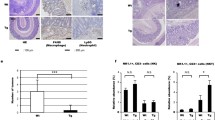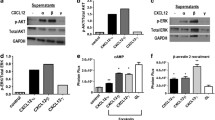Abstract
We reported previously that the forced expression of the chemokine BRAK, also called CXCL14 in head and neck squamous cell carcinoma (HNSCC) cells decreased the rate of tumor formation and size of tumor xenografts compared with mock-vector treated cells in athymic nude mice or in severe combined immunodeficiency mice. This suppression occurred even though the growth rates of these cells were the same under in vitro culture conditions, suggesting that a high expression level of the gene in tumor cells is important for the suppression of tumor establishment in vivo. The aim of this study was to determine whether CXCL14/BRAK transgenic mice show resistance to tumor cell xenografts or not. CXCL14/BRAK cDNA was introduced into male C57BL/6 J pronuclei, and 10 founder transgenic mice (Tg) were obtained. Two lines of mice expressed over 10 times higher CXCL14/BRAK protein levels (14 and 11 ng/ml plasma, respectively) than normal blood level (0.9 ng/ml plasma), without apparent abnormality. The sizes of Lewis lung carcinoma and B16 melanoma cell xenografts in Tg mice were significantly smaller than those in control wild-type mice, indicating that CXCL14/BRAK, first found as a suppressor of tumor progression of HNSCC, also suppresses the progression of a carcinoma of other tissue origin. Immunohistochemical studies showed that invasion of blood vessels into tumors was suppressed in tumor xenografts of CXCL14/BRAK Tg mice. These results indicate that CXCL14/BRAK suppressed tumor cell xenografts by functioning paracrine or endocrine fashion and that CXCL14/BRAK is a very promising molecular target for tumor suppression without side effects.




Similar content being viewed by others
References
Akhurst RJ (2002) TGF-β antagonists: why suppress a tumor suppressor? J Clin Invest 109:1533–1536
Allinen M, Beroukhim R, Cai L, Brennan C, Lahti-Domenici J, Huang H, Porter D, Hu M, Chin L, Richardson A, Schnitt S, Sellers WR, Polyak K (2004) Molecular characterization of the tumor microenvironment in breast cancer. Cancer Cell 6:17–32
Augsten M, Hagglof C, Olsson E, Stolz C, Tsagozis P, Levchenko T, Frederick MJ, Borg A, Micke P, Egevad L, Ostman A (2009) CXCL14 is an autocrine growth factor for fibroblasts and acts as a multi-modal stimulator of prostate tumor growth. Proc Natl Acad Sci USA 106:3414–3419
Belperio JA, Keane MP, Arenberg DA, Addison CL, Ehlert JE, Burdick MD, Strieter RM (2000) CXC chemokines in angiogenesis. J Leukoc Biol 68:1–8
Benatti P, Basile V, Merico D, Fantoni LI, Tagliafico E, Imbriano C (2008) A balance between NF-Y and p53 governs the pro- and anti-apoptotic transcriptional response. Nucleic Acids Res 36:1415–1428
Bissell MJ, Radisky D (2001) Putting tumours in context. Nat Rev Cancer 1:46–54
Ebos JM, Lee CR, Cruz-Munoz W, Bjarnason GA, Christensen JG, Kerbel RS (2009) Accelerated metastasis after short-term treatment with a potent inhibitor of tumor angiogenesis. Cancer Cell 15:232–239
Finak G, Bertos N, Pepin F, Sadekova S, Souleimanova M, Zhao H, Chen H, Omeroglu G, Meterissian S, Omeroglu A, Hallett M, Park M (2008) Stromal gene expression predicts clinical outcome in breast cancer. Nature Med 14:518–527
Frederick MJ, Henderson Y, Xu X, Deavers MT, Sahin AA, Wu H, Lewis DE, El-Naggar AK, Clayman GL (2000) In vivo expression of the novel CXC chemokine BRAK in normal and cancerous human tissue. Am J Pathol 156:1937–1950
Gordon JW, Scangos GA, Plotkin DJ, Barbosa JA, Ruddle FH (1980) Genetic transformation of mouse embryos by microinjection of purified DNA. Proc Natl Acad Sci USA 77:7380–7384
Hanahan D, Weinberg RA (2000) The hallmarks of cancer. Cell 100:57–70
Hromas R, Broxmeyer HE, Kim C, Nakshatri H, Christopherson K II, Azam M, Hou YH (1999) Cloning of BRAK, a novel divergent CXC chemokine preferentially expressed in normal versus malignant cells. Biochem Biophys Res Commun 255:703–706
Izukuri K, Ito S, Nozaki N, Yajima N, Iwamiya M, Kawahara S, Suzuki K, Kubota E, Hata R (2010) Determination of serum BRAK/CXCL14 level in healthy volunteers. LabMedicine (in press)
Kakinuma T, Hwang ST (2006) Chemokines, chemokine receptors, and cancer metastasis. J Leukoc Biol 79:639–651
Krieg C, Boyman O (2009) The role of chemokines in cancer immune surveillance by the adaptive immune system. Semin Cancer Biol 19:76–83
Kurth I, Willimann K, Schaerli P, Hunziker T, Clark-Lewis I, Moser B (2001) Monocyte selectivity and tissue localization suggests a role for breast and kidney-expressed chemokine (BRAK) in macrophage development. J Exp Med 194:855–861
Meuter S, Moser B (2008) Constitutive expression of CXCL14 in healthy human and murine epithelial tissues. Cytokine 44:248–255
Nara N, Nakayama Y, Okamoto S, Tamura H, Kiyono M, Muraoka M, Tanaka K, Taya C, Shitara H, Ishii R, Yonekawa H, Minokoshi Y, Hara T (2007) Disruption of CXC motif chemokine ligand-14 in mice ameliorates obesity-induced insulin resistance. J Biol Chem 282:30794–30803
Nishimura G, Yanoma S, Satake K, Ikeda Y, Taguchi T, Nakamura Y, Hirose F, Tsukuda M (2000) An experimental model of tumor dormancy therapy for advanced head and neck carcinoma. Jpn J Cancer Res 91:1199–1203
Niwa H, Yamamura K, Miyazaki J (1991) Efficient selection for high-expression transfectants with a novel eukaryotic vector. Gene 108:193–199
Ozawa S, Kato Y, Komori R, Maehata Y, Kubota E, Hata R (2006) BRAK/CXCL14 expression suppresses tumor growth in vivo in human oral carcinoma cells. Biochem Biophys Res Commun 348:406–412
Ozawa S, Kato Y, Ito S, Komori R, Shiiki N, Tsukinoki K, Ozono S, Maehata Y, Taguchi T, Imagawa-Ishiguro Y, Tsukuda M, Kubota E, Hata RI (2009a) Restoration of BRAK/CXCL14 gene expression by gefitinib is associated with antitumor efficacy of the drug in head and neck squamous cell carcinoma. Cancer Sci 100:2202–2209
Ozawa S, Kato Y, Kubota E, Hata R (2009b) BRAK/CXCL14 expression in oral carcinoma cells completely suppresses tumor cell xenografts in SCID mouse. Biomed Res 30:315–318
Paez-Ribes M, Allen E, Hudock J, Takeda T, Okuyama H, Vinals F, Inoue M, Bergers G, Hanahan D, Casanovas O (2009) Antiangiogenic therapy elicits malignant progression of tumors to increased local invasion and distant metastasis. Cancer Cell 15:220–231
Pelicano H, Lu W, Zhou Y, Zhang W, Chen Z, Hu Y, Huang P (2009) Mitochondrial dysfunction and reactive oxygen species imbalance promote breast cancer cell motility through a CXCL14-mediated mechanism. Cancer Res 69:2375–2383
Raman D, Baugher PJ, Thu YM, Richmond A (2007) Role of chemokines in tumor growth. Cancer Lett 256:137–165
Roodhart JM, Langenberg MH, Witteveen E, Voest EE (2008) The molecular basis of class side effects due to treatment with inhibitors of the VEGF/VEGFR pathway. Curr Clin Pharmacol 3:132–143
Sato K, Ozawa S, Izukuri K, Kato Y, Hata R (2010) Expression of tumor-suppressing chemokine BRAK/CXCL14 reduces cell migration rate of HSC-3 tongue carcinoma cells and stimulates attachment to collagen and formation of elongated focal adhesions in vitro. Cell Biol Int (in press).
Schaerli P, Willimann K, Ebert LM, Walz A, Moser B (2005) Cutaneous CXCL14 targets blood precursors to epidermal niches for Langerhans cell differentiation. Immunity 23:331–342
Schwarze SR, Luo J, Isaacs WB, Jarrard DF (2005) Modulation of CXCL14 (BRAK) expression in prostate cancer. Prostate 64:67–74
Shellenberger TD, Wang M, Gujrati M, Jayakumar A, Strieter RM, Burdick MD, Ioannides CG, Efferson CL, El-Naggar AK, Roberts D, Clayman GL, Frederick MJ (2004) CXCL14/BRAK is a potent inhibitor of angiogenesis and a chemotactic factor for immature dendritic cells. Cancer Res 64:8262–8270
Sidransky D (2002) Emerging molecular markers of cancer. Nat Rev Cancer 2:210–219
Starnes T, Rasila KK, Robertson MJ, Brahmi Z, Dahl R, Christopherson K, Hromas R (2006) The chemokine CXCL14 (BRAK) stimulates activated NK cell migration: implications for the downregulation of CXCL14 in malignancy. Exp Hematol 34:1101–1105
Strieter RM, Polverini PJ, Kunkel SL, Arenberg DA, Burdick MD, Kasper J, Dzuiba J, Van Damme J, Walz A, Marriott D, Chan S-Y, Roczniak S, Shanafel AB (1995) The functional role of the ELR motif in CXC chemokine-mediated angiogenesis. J Biol Chem 270:27348–27357
Suzuki K, Oida T, Hamada H, Hitotsumatsu O, Watanabe M, Hibi T, Yamamoto H, Kubota E, Kaminogawa S, Ishikawa H (2000) Gut cryptopatches: Direct evidence of extrathymic anatomical sites for intestinal T lymphopoiesis. Immunity 13:691–702
Vogelstein B, Fearon ER, Hamilton SR, Kern SE, Preisinger AC, Leppert M, Nakamura Y, White R, Smits AM, Bos JL (1988) Genetic alterations during colorectal-tumor development. N Engl J Med 319:525–532
Wang JM, Deng X, Gong W, Su S (1998) Chemokines and their role in tumor growth and metastasis. J Immunol Methods 220:1–17
Wente MN, Mayer C, Gaida MM, Michalski CW, Giese T, Bergmann F, Giese NA, Buchler MW, Friess H (2008) CXCL14 expression and potential function in pancreatic cancer. Cancer Lett 259:209–217
Yoshimura T, Matsushima K, Tanaka S, Robinson EA, Appella E, Oppenheim JJ, Leonard EJ (1987) Purification of a human monocyte-derived neutrophil chemotactic factor that has peptide sequence similarity to other host defense cytokines. Proc Natl Acad Sci USA 84:9233–9237
Zlotnik A, Yoshie O, Nomiyama H (2006) The chemokine and chemokine receptor superfamilies and their molecular evolution. Genome Biol 7:243
Acknowledgments
We appreciate Ms. Etsuko Shimada for preparation of reference list. This work was supported in part by a Grant-in Aid from the High-Tech Research Center Project of the Ministry of Education, Culture, Sports, Science and Technology of Japan and by a Grant-in Aid for Scientific Research from Japan Society for Promotion of Science.
Author information
Authors and Affiliations
Corresponding author
Additional information
Kazuhito Izukuri and Kenji Suzuki contributed equally to this work.
An erratum to this article can be found at http://dx.doi.org/10.1007/s11248-010-9436-z
Rights and permissions
About this article
Cite this article
Izukuri, K., Suzuki, K., Yajima, N. et al. Chemokine CXCL14/BRAK transgenic mice suppress growth of carcinoma cell xenografts. Transgenic Res 19, 1109–1117 (2010). https://doi.org/10.1007/s11248-010-9384-7
Received:
Accepted:
Published:
Issue Date:
DOI: https://doi.org/10.1007/s11248-010-9384-7




